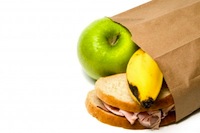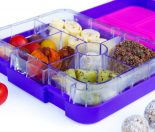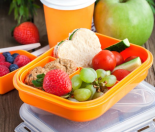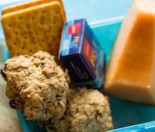This article on school lunches gives great advice from a parent and registered dietitian on what to provide for kids’ school lunch boxes.
Making school lunches may not be a popular task, but it is an important one. If you get the mix right – both with food choices that will be eaten and choices that are sustaining – then it can certainly help towards a brighter school day.
It is a well known fact that children who are fuelled well during the day have much better concentration and energy levels. It also helps to ensure that when your darling child gets home he or she is not a little monster, due to hunger and flagging energy levels.
As parents we need to take on the role of teaching good choices – this is especially true if you have a child who is really digging in their toes over lunch box choices. Kids like lunch box choices that are quick to eat and not messy.
Preparing the school lunch box
Preparing a healthy school lunch requires some thought. First you need to ensure that there are suitable choices in the cupboard, and involving your child in decision making about what they are going to eat can be helpful – as long as their preferences are good choices. Encourage your children to prepare their own packed lunch, with guidance, by using a chart of the food groups that need to be represented in each lunch.
See our printable Kiwi Families pack lunch guides below.
What to put in those school lunch boxes…
Just like any other meal the lunch box needs to be well balanced.
Generally there are 5 things that need to go into the lunch box– if you can’t include both the meat and dairy group make sure you choose at least one option from either of the following groups.
Breads and Cereal food group
These foods are carbohydrate based and therefore provide a good source of energy. Choices include:
- Bread (wraps, pita pockets, buns, raisin bread)
- Crackers
- Mini muffins or small savoury scones
- Small serves of pasta salads or rice salads, or rice in the form of sushi.
Fruit and Vegetable food group
Fruit is another good source of energy and vegetables are great for vitamins. Try to include one fruit and one salad option. Choices include:
- Fruit (raw or pottles of stewed fruit) – apples, pears, bananas, stonefruit
- Cocktail tomatoes, carrot or cucumber sticks, mini salads.
- For the more adventurous, gherkins and olives
Dairy Food group
Dairy foods are a great source of protein which satisfies hunger and helps to repair the body. Dairy-based foods are also a great source of calcium. Choices include:
- Cheese – sticks or sliced or grated in sandwiches or with crackers
- Yoghurt or yoghurt drinks
- Milk drinks and dairy food pottles (eg. chocolate or caramel yoghurts). Just be careful to watch the sugar levels on these labels.
Meat and Meat Alternative group
This is another great source of protein, and also an important source of dietary iron. Whether the protein comes from this group or the dairy group, aim to include a protein based food in the lunch box daily to help ensure your lunch box energises your child. Choices include:
- Meat – ham, chicken & fish (tuna, salmon, mackerel or sardines)
- Egg, baked beans or other dried beans – these could all be served separately, or as part of a sandwich filling, or as part of a salad.
A Drink in the school lunch box
The other really important factor to remember is to make sure your child has a drink bottle. This should be filled with water, not juice or cordial. Pop it in the freezer half-full the night before, then top it up from the tap in the morning, so that it stays cold all day. Alternatively, you could add ice cubes in the morning.
Meeting their energy requirements for school
Foods that are sustaining, nourishing and filling are the less processed ones. So if you are filling your child’s lunch box with lots of packaged foods – chippies, roll-ups, muesli bars etc., then your child may not be getting the sustained energy they need. They will also be getting a higher fat and sugar intake through these choices. These processed foods will not provide important vitamins and minerals, like the healthy choices mentioned above. Set yourself a goal of only one (or try no) pre-packaged or processed snack food in the lunch box.
Sweet treats in the packed lunch?
Including a sweeter type option in the lunch box may be suitable as children are generally active – and are growing – so they have higher energy needs than adults, per kilogram of body weight. However a treat option should be just one choice – and if you are concerned about your child’s weight then you may want to limit this further. Options like a biscuit or other baked item could be considered – but instead of always a high fat choice such as a chocolate type biscuit, consider other plain biscuits like ginger nuts, malt biscuits, wafer biscuits, hundreds and thousand biscuits, or even the bread option of raspberry fingers. When considering a muesli bar, limit the chocolate ones and ones that are covered in yoghurt – look for fruit filled or baked options.
Chippies for lunch?
What about the regular packet of chippies that so many children take to school? If these are included every day your child will think it is OK to eat chippies every day – but chippies should not be an everyday food. If you include the 25 gram bag of chips every day in the lunch box, over the week your child will get 40 grams of fat from this alone – and it is likely more chips will be eaten over the weekend. Other lower fat choices such as pretzels, flavoured rice crackers, popcorn (plain) are also good snack choices that most children like.
Food safety and school lunches
Don’t forget to consider food safety issues too. Over our hot summer months it may be wise to consider getting an insulated lunch box that keeps the food chilled through the use of a frozen mini slicker pad. These are available in most supermarkets. Alternatively, prepare the drink bottle the night before and pop it in the freezer. As it defrosts, it will keep the lunch packed with it nice and cool.
Tips for Sandwiches
Younger children love little club sandwiches, or sandwiches that are rolled up, as a change.
Still not sure what to put on that bread?
The options for sandwich fillings are endless!
Grated cheese & pineapple, cheese & vegemite, salad & cheese, ham, creamed corn, salami, jam, honey, peanut butter, cream cheese & vegemite, tuna, egg, spaghetti, baked beans, dried apricot and cream cheese, hummus & salad…
Send us more ideas to share with other kiwi families!
Useful Articles
See our great article on Healthy Breakfasts by expert nutritionist Fiona Boyle, for ideas for healthy, tempting breakfasts.
For information on which bag or box would best meet your child’s needs see our Kiwi Families article Lunch Boxes






